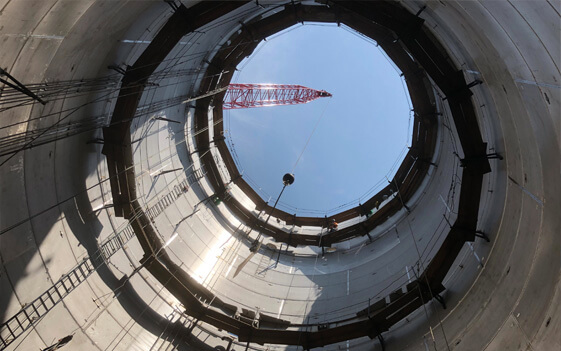Blog
Industrial wastewater recycling and reuse in production
The project implemented by Hydrotech several years ago in Kaluga, Russia, has had a longer start-up, however, its development has been quite interesting. Hydrotech received a new assignment from the customer a few months ago: to design a final (tertiary) treatment process of wastewater from wheat processing and starch derivatives production to achieve the quality required to reuse the water in production.

The wastewater treatment plant (WWTP) was designed for treatment of 2,100m3 of wastewater per day, with concentration of organic contaminants COD approx. 4,000mg/l. Such contamination is typical for cities with a population of 70,000 people.
More details about the past project development and wastewater treatment process prior to the tertiary stage will be discussed at the end.
Water quality requirements following the tertiary stage
The investor’s intention is to make the wastewater treated in the WWTP subject to reverse osmosis, a technology already available at the plant and used for the preparation of technological water necessary for the production from the city pipeline.
The input water quality for the reverse osmosis must reach concentration of organic contaminants below COD 50mg/l, concentration of insoluble substances below COD 5mg/l, concentration of microbial cultures below 100 units per milliliter etc. to make this process possible and successful.
The WWTP in place works great and the efficiency of organic contaminants removal lies between 90 to 99%, yet the pretreated water cannot enter the production or be used for the above mentioned reverse osmosis.
The effluent in such a WWTP usually contains poorly biodegradable residuals which account for a proportion of residual concentration of organic contaminants (COD) on the effluent (about 150mg/l). The light insoluble substances and microorganisms, which are not removed during the sedimentation in the basic wastewater treatment process (about 50mg/l), are present in the effluent.
Therefore, the tertiary stage was designed and implemented for the final water treatment to achieve required quality prior to the application of reverse osmosis.
1st step - activated carbon adsorption
The first step is the adsorption where powdered activated carbon is used for removing residual contaminants. The powdered carbon is added to the tank with water, making up a mixed suspended solids.
Activated carbon makes a significant contribution to the wastewater treatment process since the molecules of contaminants are adsorbed onto the surface. In our case, these are hardly biodegradable substances.
.jpg)
The disadvantage of such use of activated carbon might be its higher operational costs. The carbon needs to be exchanged continuously since it cannot be reused after the adsorption. However, this is true only to some extent.
We've decided to maximize the capacity of activated carbon in the Kaluga project. After its separation from the treated water in the tertiary stage, the carbon enters the aerobic treatment stage. This enables the adsorption of substances onto the free, unused carbon surface in the aerobic stage, raising its efficiency in removal of contaminants in the biological stage in the WWTP which might reduce the contaminants on the effluent.
This will lower the load of the tertiary stage and reduce the activated carbon demand.
2nd step - introduction of sedimentation and filtration in the tertiary stage
In the next steps of tertiary treatment following the adsorption the floc particles and major part of present insoluble substances are removed during the sedimentation and subsequent filtration conducted in sand beds.
Lighter insoluble materials, which are not removed in the sedimentation tank, are collected by the sand of 1.0 to 2.0mm grain size in the sand bed.
.jpg)
The collected insoluble materials will clog up the filter eventually, resulting in high pressure in the filter input which gives a signal that the filter has to be cleaned and the collected particles removed. Filter is washed in pretreated and pre-filtered water collected in the accumulation tank.
The washing frequency can vary depending on the efficiency of previous steps.
3rd step - water disinfection through UV irradiation
The last step of the tertiary wastewater treatment focuses on disinfection. This technology allows to remove a large portion of microbial contaminants in the water and achieve required quality.
UV radiation is produced by lamps placed in the pipes. Microorganisms exposed to the radiation for a certain period of time are inactivated. The machine and equipment maintenance is crucial to proper functioning, including sufficient cleaning of UV lamps to remove the sediments.
Past project development
We’ve designed and built a plant for anaerobic and aerobic wastewater treatment for the starch derivatives production plant which works great these days. The problem occurring in the production lies in the lack of treated technological water required for the production.
The city has limited resources and pipelines, and is not willing to supply the water. The management has decided to produce a portion of the process water using the treated wastewater.
.jpg)
Biological treatment method in the WWTP
When it comes to the basic industrial wastewater treatment, the process consists of anaerobic pretreatment in a high-load IC reactor (Internal Circulation) where 80 to 90% of organic contaminants are removed and transformed into energy-rich biogas. The remaining contaminants are removed in the aerobic phase, i.e. in aerated tanks.
Treated water with concentration of organic contaminants below COD 150mg/l and insoluble substances usually below COD 50mg/l is the final product.
As discussed, the Kaluga project is characterized by versatile use of wastewater treatment technologies. The water is recovered, biogas is produced from the wastewater, and the water can be even reused in the production.

By: Ing. Matúš Palguta, Chemical Tech
More articles
Sludge drying and incineration technologies in WWTPs. What is the future of sludge management?
The content of substances in the sludge and development of EU laws drives the efficient ways of sludge management in the WWTPs.
Successful final inspection of WWTP in the Rajo a.s. dairy
Successful final inspection of waste water treatment plant for our customer Rajo a.s. (Meggle group) was completed. The autumn 2018 will be added to...
